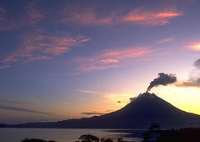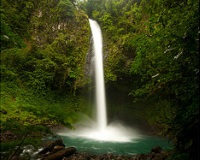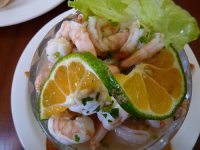Northwest Costa Rica Travel Guide
The Northwestern region of Costa Rica is renowned for its dramatic contrast in topography. Mountain ranges, volcanoes, lakes, rivers, and fertile plains support numerous varieties of bird and wildlife, and each offers different types of activities: visitors come to hike, kayak, horse ride, fish, and climb.
The two , or mountain ranges, are very different from each other. The Cordillera Tilaran has rolling mountains that used to be covered in cloud forests; those remaining are protected reserves of which the Monteverde Cloud Forest Biological Reserve is the most popular. It offers nature trails, horse riding, and canopy tours. The Cordillera de Guanacaste is a rugged and impressive string of volcanoes, some protected within national parks.
Between the ranges are Lake Arenal and the nearby active Arenal Volcano, as well as the surrounding hot springs. Further north, in the tropical humidity of the lowland plains, lies the remote wildlife refuge of Cano Negro, a vast wetlands area that is one of the best places in the Americas to see river wildlife, including numerous birds, mammals, and reptiles. The fertile plains are dotted with a mixture of agricultural fields, cattle ranches, and expanses of protected areas serviced by a maze of streams and rivers.
Things to do in Northwest Costa Rica
Northwest Costa Rica offers a stunning variety of natural landscapes and a number of world-class wildlife refuges and national parks. The region is scenically spectacular with volcanoes, forests, lakes, rivers and fertile lowlands, interspersed with small villages. Fortuna and Liberia are both good bases from which to explore the numerous attractions of Northwest Costa Rica, and the Monteverde community is an attraction in itself.
The Monteverde Cloud Forest Biological Reserve is one of the most famous attractions of Costa Rica and many visitors travel to the country primarily to experience this magical, misty forest world. The other well-known park in the region is the Arenal Volcano National Park, which attracts visitors from all over the globe with its visibly active volcano. In both parks there are a variety of hikes and activities to be enjoyed.
Although these two reserves are deservedly world-renowned, there are many other wildlife refuges and national parks in the Northwest. Santa Rosa National Park is an important sea turtle nesting area and a wonderful place to see Costa Rican animals in their natural habitat. The Bolanos Island National Wildlife Refuge is an island where a variety of seabirds, including pelicans, nest, and it has been recognised as a UNESCO World Heritage Site. White Cliffs National Wildlife Refuge and Junquillal Bay National Wildlife Refuge are two more popular wilderness areas.

Arenal Volcano National Park
The Arenal Volcano National Park is situated in what is known as the 'Energetic Heart of Costa Rica'. At its centre is the 5,356 foot (1,633m) Volcan Arenal, a typically cone-shaped volcano despite being highly active, with some huge eruptions and larva flows that killed thousands of people in 1968. Although perpetually active, the degree of activity is unpredictable, ranging from rumbling and ground shaking to a smouldering red glow best visible at night. Sometimes visitors are treated to a fiery display of red-hot rocks being thrown into the air. The park has some good trails that go through forests, passing through the area that was flattened in the 1968 eruption, or across lava fields, but fences are in place to stop people from venturing too far up the dangerous slopes. There is also a good chance of seeing some of the wildlife in the forest. The Visitor Centre has video displays of the volcano's more exciting activity. It is not possible to stay overnight in the park or visit it after dark unless on one of the night tours from Fortuna.

Fortuna
Fortuna is the nearest village to the spectacular Volcan Arenal. It has uninterrupted views of the volcano and provides a comfortable base for visiting the national park and other attractions. There are many tour operators in town offering night trips to see the red-hot volcanic activity from up close. Other tours provide a luxurious soak in the hot springs while taking in the astounding show of bright red larva coursing down the slopes. Visitors don't need a guide to enter the park and hike in the area but must have a guide to visit at night. Trips to the Cano Negro Wildlife Refuge, and the Arenal Butterfly Conservatory, are also popular excursions, as is horse riding to the nearby waterfalls and their pools. Close to Fortuna is Lake Arenal, a picturesque lake offering watersports, fishing, and stunning scenery. There are also some rivers close by: the Pena Blancas River is great for relaxing cruises, and, for the more adventurous, the Rio Toro River boasts some impressive white water rafting through deep gorges and big rapids (class 3 to 4).
Monteverde
Monteverde is a small community scattered along several kilometres of road that leads to the Monteverde Cloud Forest Biological Reserve. Originally bought for dairy farming, the reserve today is an integral part of Costa Rican society, known especially for their distinctive cheese that is sold throughout the country. After more hectares were added, it became the famous cloud forest reserve now so popular with tourists today. The village of Santa Elena is the closest settlement to the reserve and has a cloud forest reserve of its own, although much less visited. Monteverde has a number of other attractions, such as the Butterfly Garden, the Serpentarium, a cheese factory, and art galleries. CASEM Handicrafts Cooperative, made up of 140 local artisans, sells handmade goods and the profits go towards supporting the local community. There is also the Hummingbird Gallery near the entrance to the reserve that has feeders attracting several species of hummingbird. Several nature and hiking trails allow visitors to amble through coffee and banana plantations or up onto the hilltops for views of the cloud forest. On a clear day, you might get a chance to spy Arenal Volcano, and lots of birds and wildlife.

Liberia
Located 135 miles (220km) northwest of San Jose, Liberia is not so much a tourist destination as a convenient travel hub and gateway to the stunning beaches of Northwest Costa Rica. Liberia is often called 'La Ciudad Blanca' (the White City) because of the pale gravel used to make its roads and the prevalence of white colonial buildings. One of its main attractions is the nearby Rio Negro Hot Spring. In fact, most of its prime attractions are located just outside of Liberia. It's ideally situated to explore some of the stunning national parks in Costa Rica, including Rincon de la Vieja Volcano and Santa Rosa National Park. Home to Costa Rica's second largest international airport, many tourists travel through Liberia on their Costa Rica holiday.
Northwest Costa Rica Climate and Weather
The Northwest Pacific has a tropical monsoon climate and is one of the driest regions in the country. The beach areas have a fairly steady year-round temperature, with daytime highs averaging around 89F (32C), though conditions are hotter in the dry season (January to April), when there is almost no rainfall. The nicest weather occurs between November and August.
Costa Rica travel info
Electricity
Electrical current is 120 volts, 60Hz. Flat two-pin plugs and three-pin (two flat blades with round grounding pin) plugs are in use.
Language
Spanish is the official language, but English is widely spoken.
Money
The Costa Rican colon (CRC) is divided into 100 centimos and is the official currency, although US dollars are also widely accepted. US dollars can be exchanged in banks and many hotels, but currency other than US dollars is difficult to exchange. Using black market exchange options is risky, as these unofficial outlets have been known to pass on counterfeit bills printed in Colombia. Banks close anywhere from 3pm to 4pm. Major credit cards are widely accepted; ATMs are available in major towns throughout the country, but it is advisable to always have some local cash handy.
Tipping
Hotels add a 10 percent service charge and a three percent tourist tax to their bills, and a tip of 10 percent is usual in tourist areas and at upmarket restaurant. Taxi drivers are not normally tipped but passengers can use discretion if it's been a long trip or there was intense traffic. People will often round off the fare to the nearest Costa Rican colon or US dollar. Tour guides, on the other hand, are normally tipped. In general, staff will appreciate a five to 10 percent tip if service has been particularly good.
Health
Vaccinations for hepatitis A, hepatitis B, and typhoid are recommended, and a yellow fever vaccination certificate is required if visitors are arriving from a country where yellow fever occurs, excluding Argentina and Panama, or if they are coming from Tanzania or Zambia. There is a year-round risk of malaria in some regions of Costa Rica and advice should be taken on what areas are currently risky places to visit. Travellers should also find out the precautions and medication they must take to protect against the disease. Water in cities is generally safe but it is advisable to buy bottled water, especially outside the main towns where there is a risk of contamination. Dengue fever is one of a number of diseases carried by insects that also occur in this region, especially during the rainy season; protection against insect bites is the best prevention. Medical services are reliable in cities and the standard of hygiene and treatment is very high.
Safety
There is no history of terrorism in Costa Rica, though there are incidents of violent crime that occasionally target tourists. There has been an increase in attacks on tourists leaving the airport in hired cars in San Jose, so visitors should watch their belongings carefully at all times and in all places, particularly in bus stations and on public transport. Theft of, and from, cars is common. It's advisable not to wear jewellery or carry large amounts of cash, and to avoid moneychangers on the street. Strikes, protests and blockades can take place without warning, and demonstrations could disrupt travel on main roads, particularly those connecting San Jose with the coast. Visitors should check local information and plan their trip carefully, so as to stay well away from these incidents where possible.
Local customs
Costa Ricans are conservative when it comes to family values, and roles between male and female are expected to be traditional. Machismo is a key characteristic of Costa Rica culture, although women are quickly becoming more empowered in Tico society. The population is largely middle-class, Catholic, and ethnically homogenous.
Doing business
Costa Rica has a formal business environment, where men and women wear conservative suits, appointments are made and meetings begin on time. Business projects can be slow, however, as Costa Ricans are conservative in their approach to new ideas and keen to avoid risk. Spanish is the main language, but most business people speak English. Nevertheless, it is polite to have business cards as well as other promotional material printed in both English and Spanish. A lot of women have high profile jobs but the business world, like the society in general, is still male dominated. Visiting businesswomen will be treated with respect once their ability and authority is clearly established. Hours of business are generally 8am to 4pm Monday to Friday with a two-hour lunch break from 12pm.
Duty free
Travellers to Costa Rica over 18 years do not have to pay duty on 3 litres of alcohol; 500g of tobacco or 400 cigarettes or 50 cigars. Perfume for personal use is allowed provided it is a reasonable quantity.
Communications
The international access code for Costa Rica is +506. Costa Rica has one of the most advanced telecommunications systems in Latin America and WiFi is available in most hotels, restaurants, and cafes.
Passport & Visa
All foreign passengers to Costa Rica must have return or onward tickets, the necessary travel documentation for their next destination, and proof of sufficient funds to cover their stay in the country. Extensions of stay for those who are visa-exempt can be arranged on arrival. A yellow fever vaccination certificate is required if visitors are arriving in Costa Rica from a country where yellow fever occurs, excluding Argentina and Panama, or if they are coming from Tanzania or Zambia. It is highly recommended that travellers' passports have at least six months' validity remaining after the intended date of departure from their travel destination. Immigration officials often apply different rules to those stated by travel agents and official sources.
Entry requirements
US citizens must have a passport that is valid upon their arrival in Costa Rica. No visa is required for stays of up to 90 days.
British citizens must have a passport that is valid upon their arrival in Costa Rica. A visa is not required for stays of up to 90 days, provided the passport is for an endorsed British Citizen or British Overseas Territories Citizen. A British National (Overseas) does not require a visa for a stay of up to 30 days.
Canadian citizens must have a passport that is valid upon their arrival in Costa Rica. No visa is required for stays of up to 90 days.
Australian citizens must have a passport that is valid upon their arrival in Costa Rica. No visa is required for stays of up to 90 days.
South African citizens must have a passport that is valid upon their arrival in Costa Rica. No visa is required for stays of up to 90 days.
Irish citizens must have a passport that is valid upon their arrival in Costa Rica. No visa is required for stays of up to 90 days.
New Zealand citizens must have a passport that is valid upon their arrival in Costa Rica. No visa is required for stays of up to 90 days.
Useful contacts
Costa Rica Tourism Board, San Jose: www.visitcostarica.com
911 (General Emergency Helpline)Embassies / consulates in other countries
Embassy of Costa Rica, Washington DC, United States: +1 202 499 2991.
Embassy of Costa Rica, London, United Kingdom (also responsible for Ireland): +44 (0)20 7706 8844.
Embassy of Costa Rica, Ottawa, Canada: +1 613 562 2855.
Costa Rica Consulate-General, Sydney, Australia (also responsible for New Zealand): +61 2 9262 3883
Honorary Consulate of Costa Rica, Johannesburg, South Africa: +27 (0)11 486 4716.
Embassies / consulates in Costa Rica
United States Embassy, San Jose: +506 2519 2000.
British Embassy, San Jose: +506 2258 2025.
Canadian Embassy, San Jose (also responsible for Australia): +506 2242 4400.
South African Consulate-General, San Jose: (+506) 222 1470



